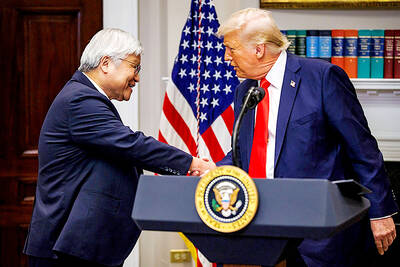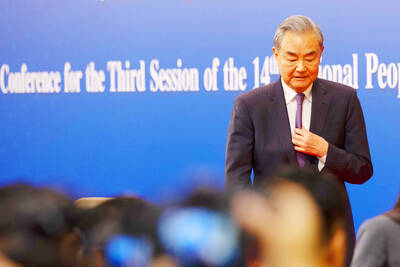Taiwanese research institutions clinched 12 prizes in this year’s R&D 100 Awards, the most of any nation in Asia and the second-most worldwide behind only the US, the Ministry of Economic Affairs said yesterday, adding that the results represented recognition of the nation’s achievements in technology research and development.
The US obtained 72 awards while the rest of the world excluding Taiwan took 16 prizes in this year’s listing.
Taiwan’s performance in the research-and-development event proved the push to boost technology via government-business cooperation is bearing fruit, Deputy Minister of Economic Affairs Lin Chuan-neng (林全能) told a news conference in Taipei.

Photo: screen grab from the Ministry of Economic Affairs Web site
Taiwan has significantly fewer research-and-development institutions than the US, but won a comparable number of awards, he said, adding that the Industrial Technology Research Institute (ITRI) alone claimed eight awards, which topped the Massachusetts Institute of Technology.
The nation’s success was thanks to being able to identify the types of innovations being demanded, robust research-and-development institutions capable of achieving genuine breakthroughs and a high level of integration in public-private-sector partnerships, Lin said.
The patents created by the nation’s researchers originated from projects that the ministry conceived and implemented in cooperation with Metagone Biotech, Compal Electronics, Kao Fong Machinery and Asahi-Utou Technology, among others, he said.
This year’s awards also marked the fifth consecutive year Taiwanese innovation in biomedicine gained recognition in the awards, with three patents receiving a distinction, he said, adding that the nation’s biomedical sector has firmly established itself as a global player.
ITRI gaining eight prizes is a rare achievement and the group is proud of the work it has performed, institute president Liu Wen-hsiung (劉文雄) said.
The technologies developed and patented by the ITRI that received honors include eye drops for treating macular degeneration, targeted glaucoma drugs, surgical electrode needles and green technology for manufacturing polyimide films, he said.
They additionally included precision manufacturing software, an energy-saving private network solution, a thin-film technology for next-generation semiconductor processing and software for managing power battery rotation systems, he said.
Metal Industries Research & Development Center’s advanced electrochemical machining system, the Taiwan Textile Research Institute’s thermostatic leather, the Institute for Information Industry’s industrial cybersecurity platform and the Institute of Nuclear Energy Research’s bioplastics conversion technology for forestry waste were also awarded.

CRITICAL MOVE: TSMC’s plan to invest another US$100 billion in US chipmaking would boost Taiwan’s competitive edge in the global market, the premier said The government would ensure that the most advanced chipmaking technology stays in Taiwan while assisting Taiwan Semiconductor Manufacturing Co (TSMC, 台積電) in investing overseas, the Presidential Office said yesterday. The statement follows a joint announcement by the world’s largest contract chipmaker and US President Donald Trump on Monday that TSMC would invest an additional US$100 billion over the next four years to expand its semiconductor manufacturing operations in the US, which would include construction of three new chip fabrication plants, two advanced packaging facilities, and a research and development center. The government knew about the deal in advance and would assist, Presidential

‘DANGEROUS GAME’: Legislative Yuan budget cuts have already become a point of discussion for Democrats and Republicans in Washington, Elbridge Colby said Taiwan’s fall to China “would be a disaster for American interests” and Taipei must raise defense spending to deter Beijing, US President Donald Trump’s pick to lead Pentagon policy, Elbridge Colby, said on Tuesday during his US Senate confirmation hearing. The nominee for US undersecretary of defense for policy told the Armed Services Committee that Washington needs to motivate Taiwan to avoid a conflict with China and that he is “profoundly disturbed” about its perceived reluctance to raise defense spending closer to 10 percent of GDP. Colby, a China hawk who also served in the Pentagon in Trump’s first team,

SEPARATE: The MAC rebutted Beijing’s claim that Taiwan is China’s province, asserting that UN Resolution 2758 neither mentions Taiwan nor grants the PRC authority over it The “status quo” of democratic Taiwan and autocratic China not belonging to each other has long been recognized by the international community, the Mainland Affairs Council (MAC) said yesterday in its rebuttal of Beijing’s claim that Taiwan can only be represented in the UN as “Taiwan, Province of China.” Chinese Minister of Foreign Affairs Wang Yi (王毅) yesterday at a news conference of the third session at the 14th National People’s Congress said that Taiwan can only be referred to as “Taiwan, Province of China” at the UN. Taiwan is an inseparable part of Chinese territory, which is not only history but

INVESTMENT WATCH: The US activity would not affect the firm’s investment in Taiwan, where 11 production lines would likely be completed this year, C.C. Wei said Investments by Taiwan Semiconductor Manufacturing Co (TSMC, 台積電) in the US should not be a cause for concern, but rather seen as the moment that the company and Taiwan stepped into the global spotlight, President William Lai (賴清德) told a news conference at the Presidential Office in Taipei yesterday alongside TSMC chairman and chief executive officer C.C. Wei (魏哲家). Wei and US President Donald Trump in Washington on Monday announced plans to invest US$100 billion in the US to build three advanced foundries, two packaging plants, and a research and development center, after Trump threatened to slap tariffs on chips made